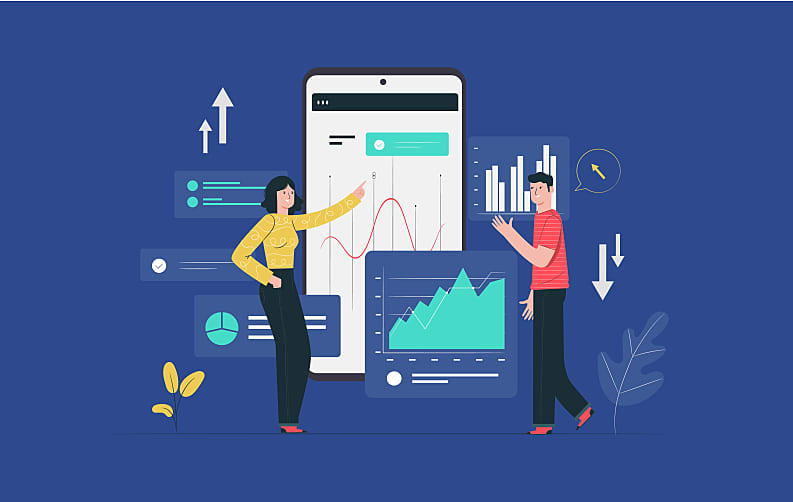
-
Top mobile app industry statistics
- App statistics to show store-wise apps availability
- Number of mobile app download statistics from 2016 to 2020
- By 2022, annual consumer spending will reach up to $157 billion
- Leading app categories in the US market
- The distribution ratio of free and paid Android apps on the Google play store
- Distribution of free and paid iOS apps on the Apple app store
- Mobile app statistics with the most time spent on each category
- App usage growth and revenue statistics
- Apple app store and Google play store revenue
- Gaming and non- gaming app revenues
- iOS and Android gaming apps’ revenues
- Some other app usage statistics you might find useful
- Conclusion

Now when almost everyone has a smartphone, the app market has grown exponentially. Currently, smartphone apps are being used to execute many daily and non-daily tasks. From the healthcare sector to the entertainment sector, the app market has infiltrated almost every industry.
If we consider app download statistics, the number of mobile apps downloaded is expected to reach 258 billion by 2022. This forecast was done by App Annie. In this blog, you will find some statistics on the app market exposing facts like the one I mentioned.
Top mobile app industry statistics
Now, without wasting much time, let’s dive into the list of major app usage statistics. These statistics can give you an insight into the app market and genres of the app market which are growing rapidly.
1. App statistics to show store-wise apps availability
Currently, Google play store has 2.87 million apps available. The data is based on the information till the third quarter of 2020. However, the iOS App Store had 1.96 million apps available for users to download.
According to app store statistics by Statista, Google play store and iOS app store secured first and second place in the app store market respectively. However, these app downloads stats might vary depending on the filtration process these app stores follow.
2. Number of mobile app download statistics from 2016 to 2020
As per mobile app usage statistics shared by Statista, In 2020, users downloaded 218 billion mobile apps compared to 140.7 billion apps downloaded in 2016. Moreover, if we focus on the Apple app store download statistics for 2020, 21.86 percent of apps downloaded belong to the Gaming category. Apart from these statistics, there is another fact that 108.5 billion apps were downloaded from the Google Play Store itself between 2016 to 2020.
3. By 2022, annual consumer spending will reach up to $157 billion
According to the mobile usage statistics of App Annie, consumer spending will increase by 92 percent from 2017 and touch average annual spending of $157 billion. It will include a 23 percent increase per device since 2017. The new average annual spending on each device will reach $26 by 2022. This amount was below $21 per device according to mobile app statistics from 2017. If you are interested in tackling the market and making an effective app revenue, you should start planning!
4. Leading app categories in the US market
According to Statista app usage stats, Communication and social apps have covered 97.9 percent of the app market in the US After that, web browsers are standing on the second position from the top with 97.6 percent of the app market share. However, Gambling & Lottery apps had the least share of the market with 9.3 percent in September 2019.
5. The distribution ratio of free and paid Android apps on the Google play store
According to mobile app industry statistics shared by Statista, until January 2021, 96.7 percent of Android apps on the Google Play Store were available for free to users. Moreover, this share was limited to 95.6 percent in June 2019. The distribution of free apps on the Google Play Store might increase as their popularity is much higher compared to paid apps.
6. Distribution of free and paid iOS apps on the Apple app store
By January 2021, there were around 92.7 percent free apps compared to 7.3 percent paid apps on the Apple App Store. Moreover, this segregation has been boosting since June 2019. In June 2019, free apps had a 90 percent market share of the iOS apps on the Apple App Store compared to 10 percent which premium apps had.
7. Mobile app statistics with the most time spent on each category
Among all categories, time spent on social media apps or chat apps was the most by the users in the US As of the third quarter of 2019, 49 percent of users used Social media and chat apps the most. In the second position, web browsers made their place. Moreover, other segments like gaming apps and news apps covered 26 percent and 17 percent respectively.
8. App usage growth and revenue statistics
According to App Annie, iOS and Android apps generated $31.9 billion in the fourth quarter of 2020 combined. In the first quarter of 2016, the generated revenue was $9.1 billion. These app usage stats show how rapidly the app market has grown. Moreover, these app revenue statistics include in-app expenses, app prices, subscriptions, additional items, etc.
9. Apple app store and Google play store revenue
If we go through app downloads stats, the App store always stays behind the Google Play Store. However, in terms of revenue, the App Store has been defeating its toughest alternative for quite some time.
Apple’s app store has generated a revenue of $21.4 billion in the fourth quarter of 2020. The same-store generated $6 billion in the first quarter of 2016. However, Google play store generated $10.4 billion in the fourth quarter of 2020 which increased from a revenue of $3.1 billion in the first quarter of 2016.
10. Gaming and non- gaming app revenues
Among all categories, Gaming apps have a big advantage. Especially if you make a mobile game and it gets viral-like PUBG Mobile did. In 2020, the spending amount on PUBG Mobile by gamers touched $221 million. Moreover, the game has been downloaded over 730 million times on iOS, Windows, and Android devices combined.
On the other hand, if we focus on the non-gaming app revenue, in the first quarter of total non-gaming app revenue was $1 billion. However, this graph rose and touched $10.1 billion in 2020.
11. iOS and Android gaming apps’ revenues
Even in this segment, Apple’s app store successfully defeated the Google Play store continuously in every quarter. In the last quarter of 2020, the revenue generated by iOS apps was $13 billion. However, Google Play Store stayed behind in the same segment with $8.8 billion.
12. Some other app usage statistics you might find useful
- In 2019, only, IoT segment saw over 106 million app downloads for the top 20 IoT apps in the US market;
- Amazon Alexa secured the first position among most IoT apps downloaded in 2019 in the US market;
- 98 percent of Gen Z users own a smartphone and has 60 percent sessions per user in top apps;
- On average, Gen Z spent 3.8 hours per month on each app;
- In 2019, according to global app usage stats shared by App Annie, most downloaded game genres kept Casual Arcade games on the top.
Conclusion
If we focus on app download statistics discussed above, targeting Gen Z as the potential app user can boost the growth of your app. However, to compete with millions of apps existing in the market, your app will have to be more than perfect.
Apple’s App Store and Google Play Store keep removing mobile apps from the portal almost every day. These apps get filtered because of various reasons like violations of rules, poor ratings, constantly low numbers of downloads, etc.
To make your app stand on the top, you can not only focus on adding features; you will have to keep marketing strategies in the mind as well. App marketing is one of the crucial tasks you need to execute. You can either do it yourself or you can hire the best app marketing agencies to do that for you. Even though this process might be costly, a good marketing strategy can help you in generating good revenue in return.









